PCV vs EVAC
Moderator: Team
-
rustbucket79
- Guru

- Posts: 2151
- Joined: Fri Apr 07, 2006 8:23 pm
- Location:
Re: PCV vs EVAC
What’s stopping you from installing a high volume mechanical fuel pump and plumbing the inlet side to a valve cover and the outlet to a catch can? (Engine otherwise sealed from atmospheric) Is there a rule against it?
Re: PCV vs EVAC
Chad, going to the pump right? Good time to manometer test. I think I would be scared to do only PCV system as in pressure in the higher rpm.
I think I would do PCV with breather - then pvc with Vacu-pan breathers -then just vacu-pan?
Or did I miss that in the threads?
I think I would do PCV with breather - then pvc with Vacu-pan breathers -then just vacu-pan?
Or did I miss that in the threads?
-
SpeierRacingHeads
- Vendor
- Posts: 943
- Joined: Sun May 13, 2012 1:28 pm
- Location: KS
- Contact:
Re: PCV vs EVAC
Here is what I ended up doing for a evac system. Doesn't work just a little hole and some fittings.






-
weedburner
- New Member

- Posts: 43
- Joined: Fri Sep 07, 2018 11:20 am
- Location:
Re: PCV vs EVAC
Here's some pics of the DIY pcv based evac system currently on the street/strip Shop Mule car. Here's what's inside a common stock pcv valve...
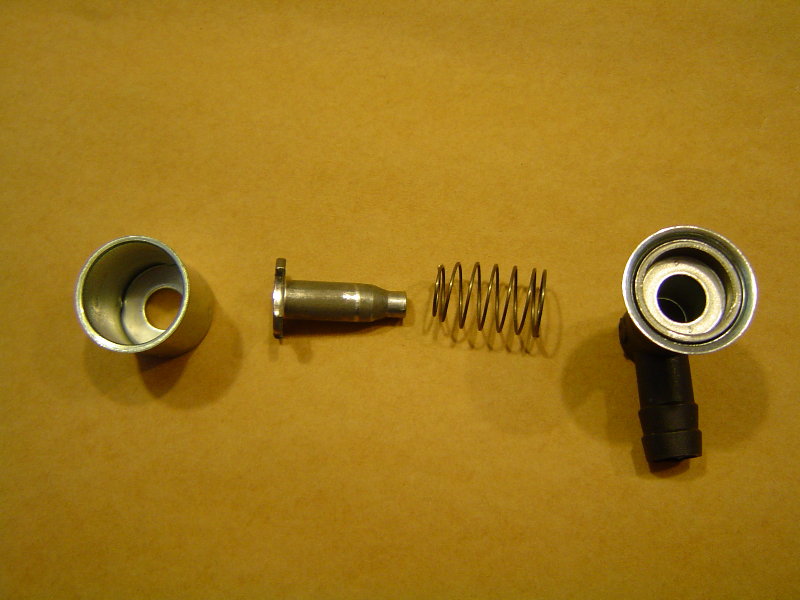
I modified the valve by adding a long screw to the top of the valve's plastic elbow, which allows me to adjust the minimum flow position of the valve's tapered piston. Basically by adding that adjustment screw, I basically turned the pcv valve into an adjustable orifice without disabling it's reverse flow check-valve feature...
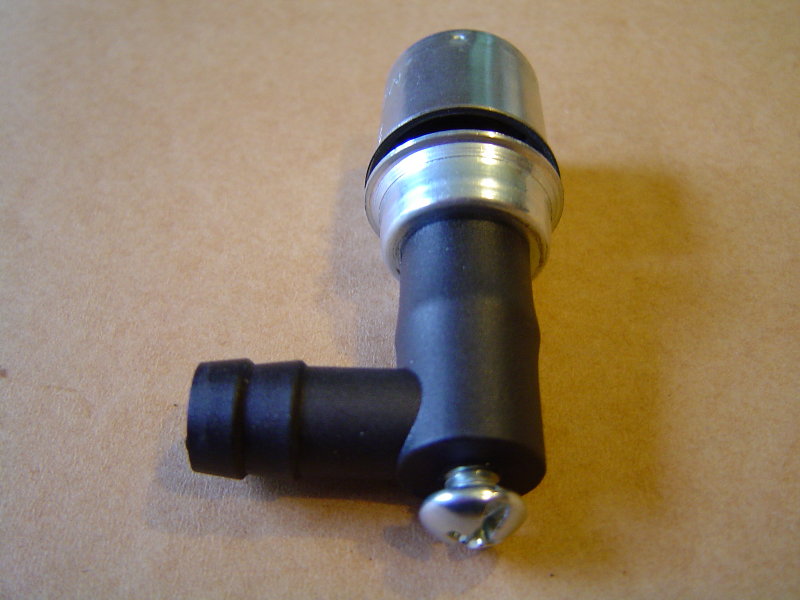
Here's a shot from the inside showing the screw added to the elbow...
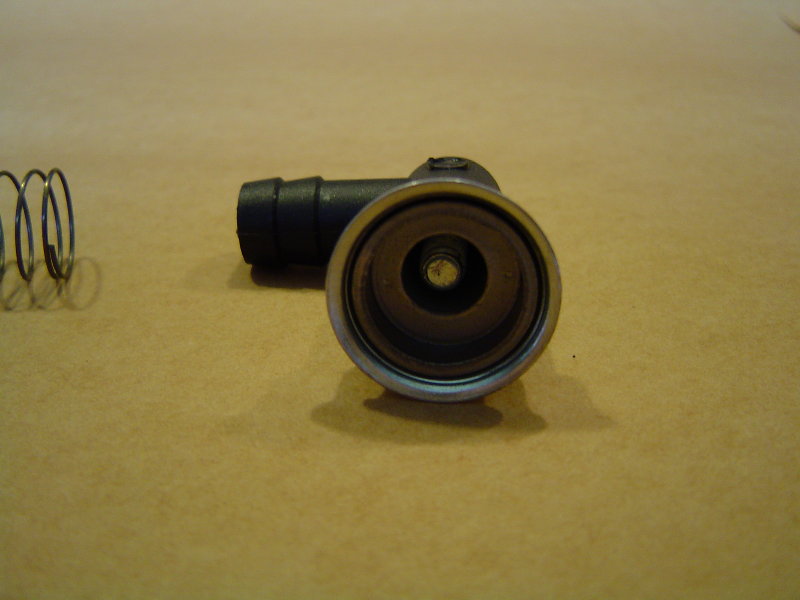
The plastic elbow just pushes onto the valve, i took this elbow with the screw added and installed it on a valve that had not been cut open. Here it is installed on the car, the pcv valve in the center of the below pic is the engine's only crankcase vacuum source.
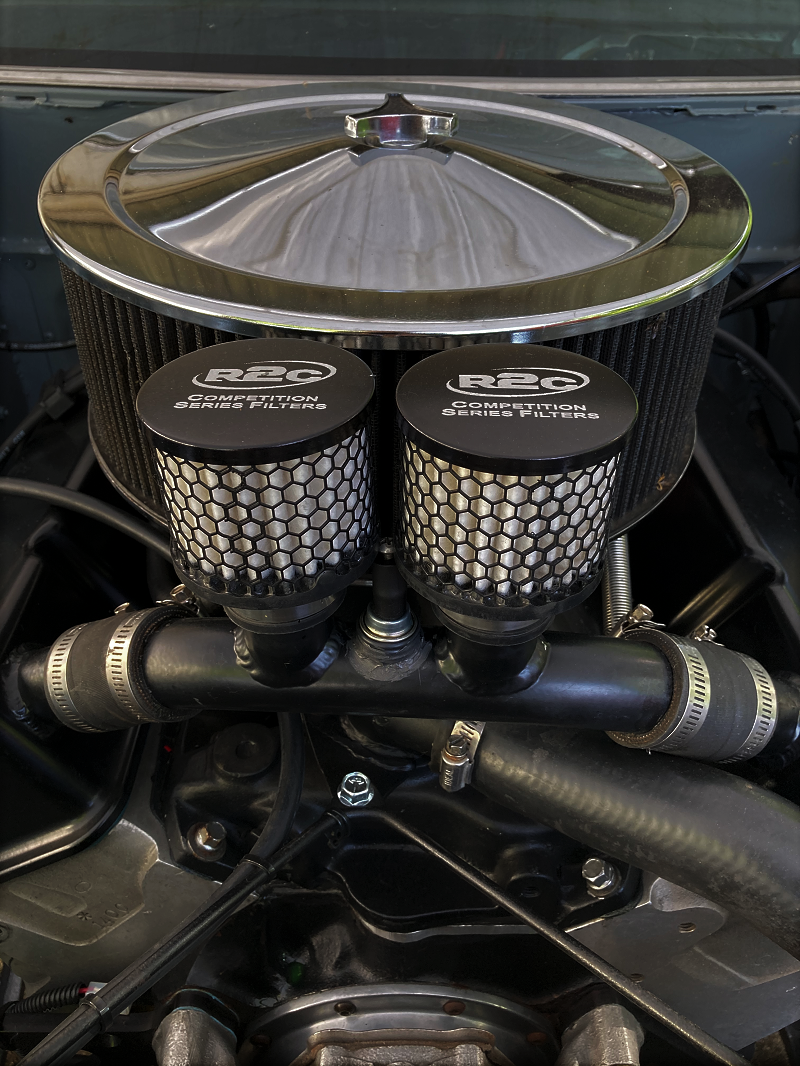
System features a set of check valves inside the breathers, which makes it possible for the pcv valve to draw a vacuum inside the engine. The push-in check valve seats were machined from Delrin, the check balls themselves are 1" dia nylon bearing balls. If the crankcase ever goes positive pressure, the check valves get pushed open allowing the pressure to exit...
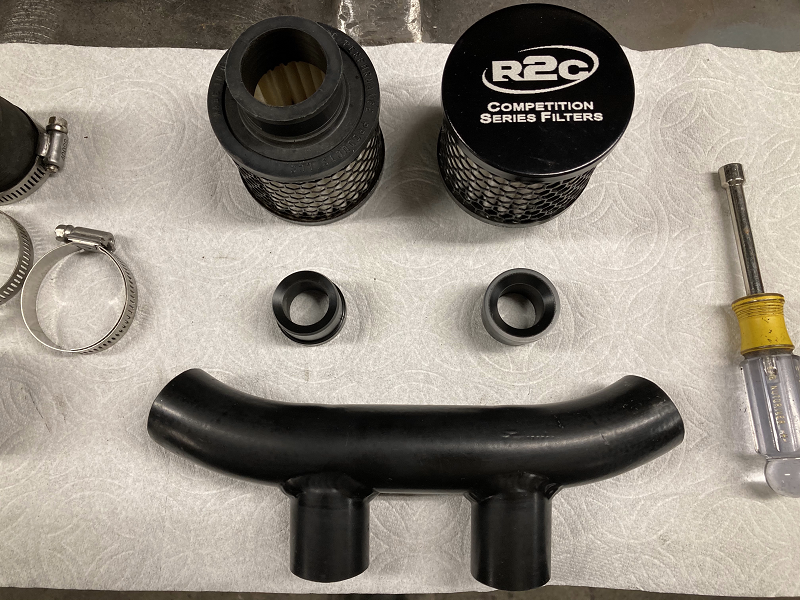
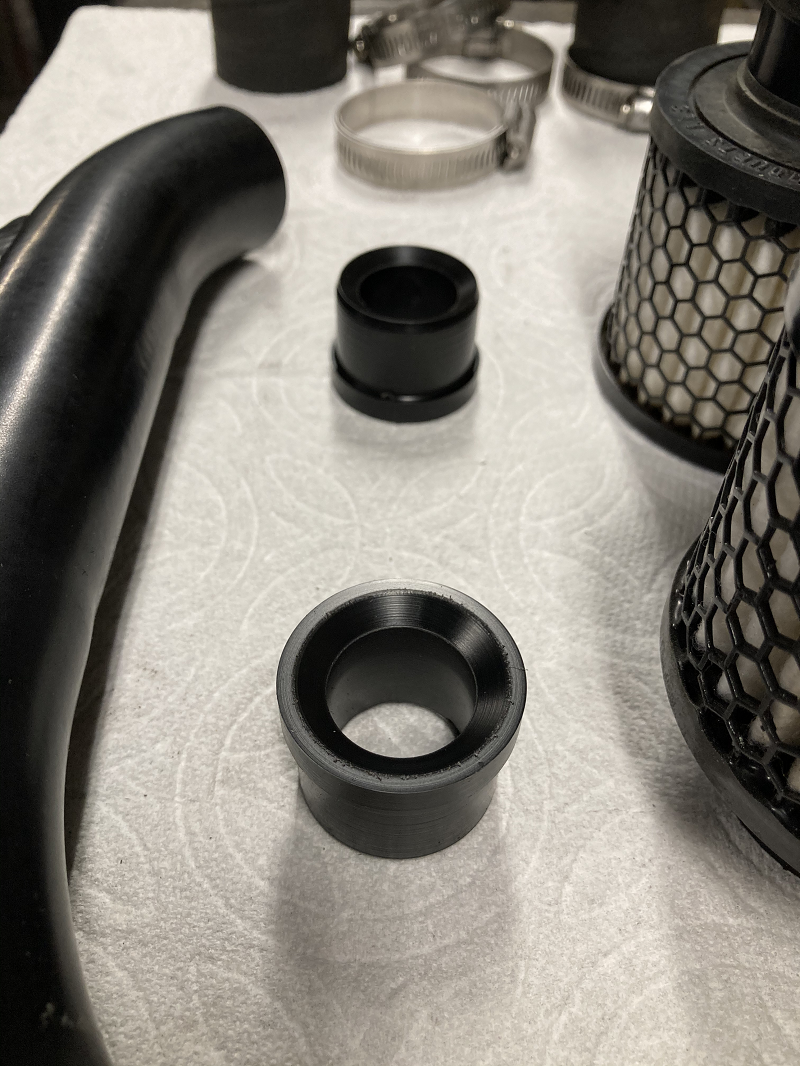

I've been running a pcv/sealed crankcase setup since 2012 with a couple different engines, with crank seals are reversed. Rear seal is a fluoroelastomer 2912 Felpro, which seems to last pretty good reversed against this much vacuum. Front seal is viton SCE 21102, it had to be replaced last winter. I think next front seal will be one designed for a reverse rotation boat engine, my thinking is that the small directional ribs going in the wrong direction will help lube the seal lip. No signs of wrist pin oiling issues @ 15-16"Hg.
Here's a RacePak graph from 3 years ago showing crankcase vacuum during a 6.25sec long WOT 3rd gear pull...
...Red line- engine rpm
...Blue line- WOT switch
...Yellow line- crankcase vacuum
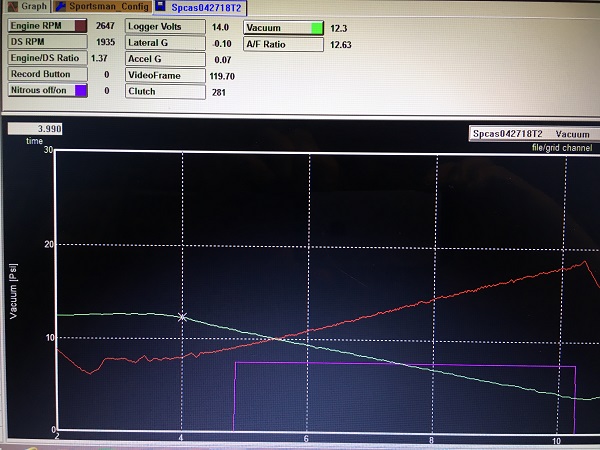
The pull started out with 12.6"Hg @ 2600rpm. When the pull ended at 6250rpm, the crankcase still had 3.9"Hg of vacuum left. I should add that the engine is well sealed, no dipstick (oil level sight tube).
This car has no overdrive, it's 3133rpm @ 70mph. Gets spun past 8600 fairly regularly and still gets 20+ mpg on the highway. Low tension rings are the biggest reason it gets great fuel mileage while spinning that fast without overdrive. The modified pcv valve, combined with a sealed crankcase, is key to making the low tension rings work on the highway without excessive oil consumption. If the crankcase ever goes positive pressure, the check valves open up to relieve any pressure thru the breathers.
Here's a pic of the system before I added the check ball breathers, it featured a diy separator can with the modified pcv valve located in it's top, also featured o-ringed push-in connections at the valve covers to aid valve cover removal...
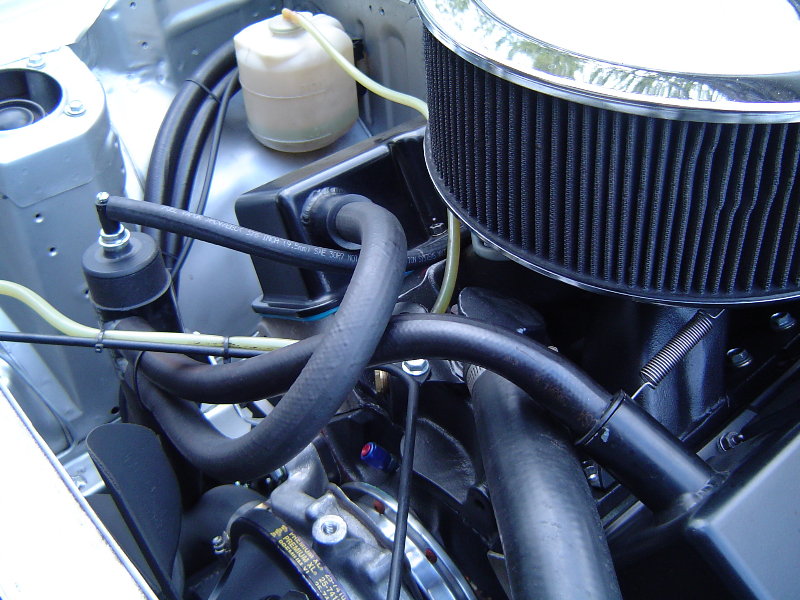
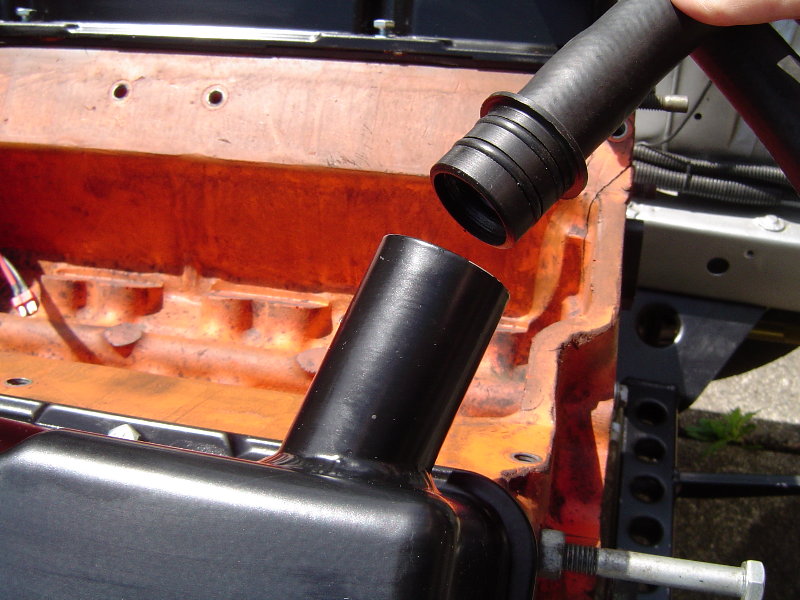
The check-ball breather system at the top of my post is lighter, proved work just as well.
Grant

I modified the valve by adding a long screw to the top of the valve's plastic elbow, which allows me to adjust the minimum flow position of the valve's tapered piston. Basically by adding that adjustment screw, I basically turned the pcv valve into an adjustable orifice without disabling it's reverse flow check-valve feature...

Here's a shot from the inside showing the screw added to the elbow...

The plastic elbow just pushes onto the valve, i took this elbow with the screw added and installed it on a valve that had not been cut open. Here it is installed on the car, the pcv valve in the center of the below pic is the engine's only crankcase vacuum source.

System features a set of check valves inside the breathers, which makes it possible for the pcv valve to draw a vacuum inside the engine. The push-in check valve seats were machined from Delrin, the check balls themselves are 1" dia nylon bearing balls. If the crankcase ever goes positive pressure, the check valves get pushed open allowing the pressure to exit...



I've been running a pcv/sealed crankcase setup since 2012 with a couple different engines, with crank seals are reversed. Rear seal is a fluoroelastomer 2912 Felpro, which seems to last pretty good reversed against this much vacuum. Front seal is viton SCE 21102, it had to be replaced last winter. I think next front seal will be one designed for a reverse rotation boat engine, my thinking is that the small directional ribs going in the wrong direction will help lube the seal lip. No signs of wrist pin oiling issues @ 15-16"Hg.
Here's a RacePak graph from 3 years ago showing crankcase vacuum during a 6.25sec long WOT 3rd gear pull...
...Red line- engine rpm
...Blue line- WOT switch
...Yellow line- crankcase vacuum

The pull started out with 12.6"Hg @ 2600rpm. When the pull ended at 6250rpm, the crankcase still had 3.9"Hg of vacuum left. I should add that the engine is well sealed, no dipstick (oil level sight tube).
This car has no overdrive, it's 3133rpm @ 70mph. Gets spun past 8600 fairly regularly and still gets 20+ mpg on the highway. Low tension rings are the biggest reason it gets great fuel mileage while spinning that fast without overdrive. The modified pcv valve, combined with a sealed crankcase, is key to making the low tension rings work on the highway without excessive oil consumption. If the crankcase ever goes positive pressure, the check valves open up to relieve any pressure thru the breathers.
Here's a pic of the system before I added the check ball breathers, it featured a diy separator can with the modified pcv valve located in it's top, also featured o-ringed push-in connections at the valve covers to aid valve cover removal...


The check-ball breather system at the top of my post is lighter, proved work just as well.
Grant
Last edited by weedburner on Mon Apr 18, 2022 11:53 am, edited 2 times in total.
-
SpeierRacingHeads
- Vendor
- Posts: 943
- Joined: Sun May 13, 2012 1:28 pm
- Location: KS
- Contact:
Re: PCV vs EVAC
That's awesome. But this car leaves at 6500 and lights at 8800. Just not sure it would work any better??weedburner wrote: ↑Mon Apr 18, 2022 11:43 am Here's some pics of the DIY pcv based evac system currently on the street/strip Shop Mule car. Here's what's inside a common stock pcv valve...
I modified the valve by adding a long screw to the top of the valve's plastic elbow, which allows me to adjust the minimum flow position of the valve's tapered piston. Basically by adding that adjustment screw, I basically turned the pcv valve into an adjustable orifice without disabling it's reverse flow check-valve feature...
Here's a shot from the inside showing the screw added to the elbow...
The plastic elbow just pushes onto the valve, i took this elbow with the screw added and installed it on a valve that had not been cut open. Here it is installed on the car, the pcv valve in the center of the below pic is the engine's only crankcase vacuum source.
System features a set of check valves inside the breathers, which makes it possible for the pcv valve to draw a vacuum inside the engine. The push-in check valve seats were machined from Delrin, the check balls themselves are 1" dia nylon bearing balls. If the crankcase ever goes positive pressure, the check valves get pushed open allowing the pressure to exit...
I've been running a pcv/sealed crankcase setup since 2012 with a couple different engines, with crank seals are reversed. Rear seal is a fluoroelastomer 2912 Felpro, which seems to last pretty good reversed against this much vacuum. Front seal is viton SCE 21102, it had to be replaced last winter. I think next front seal will be one designed for a reverse rotation boat engine, my thinking is that the small directional ribs going in the wrong direction will help lube the seal lip. No signs of wrist pin oiling issues @ 15-16"Hg.
Here's a RacePak graph from 3 years ago showing crankcase vacuum during a 6.25sec long WOT 3rd gear pull...
...Red line- engine rpm
...Blue line- WOT switch
...Yellow line- crankcase vacuum
The pull started out with 12.6"Hg @ 2600rpm. When the pull ended at 6250rpm, the crankcase still had 3.9"Hg of vacuum left. I should add that the engine is well sealed, no dipstick (oil level sight tube).
This car has no overdrive, it's 3133rpm @ 70mph. Gets spun past 8600 fairly regularly and still gets 20+ mpg on the highway. Low tension rings are the biggest reason it gets great fuel mileage while spinning that fast without overdrive. The modified pcv valve, combined with a sealed crankcase, is key to making the low tension rings work on the highway without excessive oil consumption. If the crankcase ever goes positive pressure, the check valves open up to relieve any pressure thru the breathers.
Here's a pic of the system before I added the check ball breathers, it featured a diy separator can and push-in connections at the valve covers...
The check-ball breather system above is lighter and proved work just as well.
Grant
-
weedburner
- New Member

- Posts: 43
- Joined: Fri Sep 07, 2018 11:20 am
- Location:
Re: PCV vs EVAC
I added some pics to the bottom of my above post, they show my previous system that featured a separator can. It featured an electric vac pump as back-up for the pcv valve. The check ball breather setup is lighter and works just as well. I'm no stranger to leaving at hi rpm, i'm the guy that invented the ClutchTamer and Hitmaster clutch hit controllers.
Grant
Grant
-
SpeierRacingHeads
- Vendor
- Posts: 943
- Joined: Sun May 13, 2012 1:28 pm
- Location: KS
- Contact:
-
weedburner
- New Member

- Posts: 43
- Joined: Fri Sep 07, 2018 11:20 am
- Location:
Re: PCV vs EVAC
My point was that I previously used an electric pump as backup for the pcv valve crankcase vacuum source. Turned out the electric pump was not needed for my application, so I simplified the setup by eliminating the electric pump/separator/hoses. Moved the check valve inside a couple breathers, which in-turn eliminated excess plumbing/weight.
The bottom fitting on the catch can was plumbed to the electric pump, the outlet of the electric pump used a header evac style check valve to prevent a vacuum leak when the electric pump was not being used...
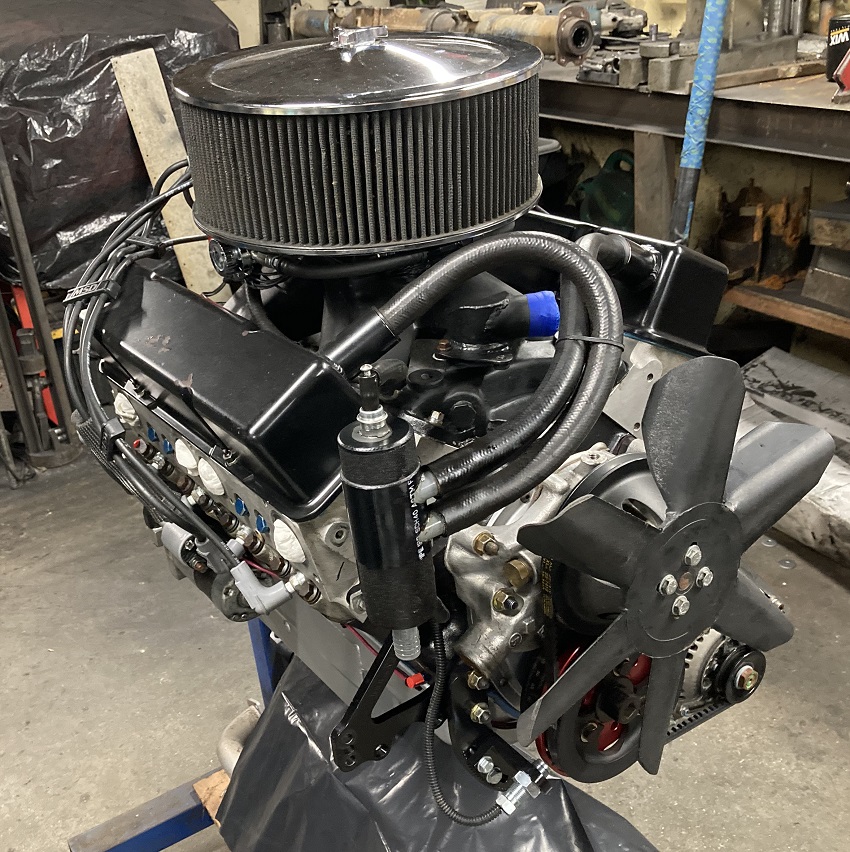
I the end I didn't need all that extra plumbing, simple pvc valve and internal check ball breathers gets the job done, no catch can or electric pump required.

Grant
The bottom fitting on the catch can was plumbed to the electric pump, the outlet of the electric pump used a header evac style check valve to prevent a vacuum leak when the electric pump was not being used...

I the end I didn't need all that extra plumbing, simple pvc valve and internal check ball breathers gets the job done, no catch can or electric pump required.

Grant
-
SpeierRacingHeads
- Vendor
- Posts: 943
- Joined: Sun May 13, 2012 1:28 pm
- Location: KS
- Contact:
Re: PCV vs EVAC
weedburner wrote: ↑Mon Apr 18, 2022 12:51 pm My point was that I previously used an electric pump as backup for the pcv valve crankcase vacuum source. Turned out the electric pump was not needed for my application, so I simplified the setup by eliminating the electric pump/separator/hoses. Moved the check valve inside a couple breathers, which in-turn eliminated excess plumbing/weight.
The bottom fitting on the catch can was plumbed to the electric pump, the outlet of the electric pump used a header evac style check valve to prevent a vacuum leak when the electric pump was not being used...
I the end I didn't need all that extra plumbing, simple pvc valve and internal check ball breathers gets the job done, no catch can or electric pump required.
Grant
And your saying it pulled 15-16"? Same as a Starr vacuum pump?
-
weedburner
- New Member

- Posts: 43
- Joined: Fri Sep 07, 2018 11:20 am
- Location:
Re: PCV vs EVAC
Pulls 15-16" going down the highway, it's a street/strip car.
Pcv doesn't draw a lot of volume, so the engine has to be sealed up pretty good for it to work. Not much vacuum in the intake tract to draw in the crankcase after going WOT, but you have a lot of crankcase volume (big pan helps), so it takes a while for the pre-wot crankcase Hg to draw down after going wot. Hopefully there's enough crankcase vacuum on the starting line to last the whole pass, but if it goes positive the engine can then breathe thru the check balls/breathers.
Grant
Pcv doesn't draw a lot of volume, so the engine has to be sealed up pretty good for it to work. Not much vacuum in the intake tract to draw in the crankcase after going WOT, but you have a lot of crankcase volume (big pan helps), so it takes a while for the pre-wot crankcase Hg to draw down after going wot. Hopefully there's enough crankcase vacuum on the starting line to last the whole pass, but if it goes positive the engine can then breathe thru the check balls/breathers.
Grant
-
SpeierRacingHeads
- Vendor
- Posts: 943
- Joined: Sun May 13, 2012 1:28 pm
- Location: KS
- Contact:
Re: PCV vs EVAC
Chad:
I'm not sure you can run a set-up like that without some kind of flow restriction (or maybe I didn't see one in your set-up). The crankcase will look like a massive vacuum leak. Someone posted a picture of the Wagner dual circuit PCV earlier, you might check it out:
http://mewagner.com/
It has two separate adjustable circuits for idle and cruise and would allow you to tailor the crankcase vacuum for your specific motor. I am using one on a street motor, but never tried it on a competition motor.
I'm not sure you can run a set-up like that without some kind of flow restriction (or maybe I didn't see one in your set-up). The crankcase will look like a massive vacuum leak. Someone posted a picture of the Wagner dual circuit PCV earlier, you might check it out:
http://mewagner.com/
It has two separate adjustable circuits for idle and cruise and would allow you to tailor the crankcase vacuum for your specific motor. I am using one on a street motor, but never tried it on a competition motor.
-
SpeierRacingHeads
- Vendor
- Posts: 943
- Joined: Sun May 13, 2012 1:28 pm
- Location: KS
- Contact:
Re: PCV vs EVAC
The problem is, I or we don't care about idle or cruise in a all out drag engine.Cris wrote: ↑Mon Apr 18, 2022 5:22 pm Chad:
I'm not sure you can run a set-up like that without some kind of flow restriction (or maybe I didn't see one in your set-up). The crankcase will look like a massive vacuum leak. Someone posted a picture of the Wagner dual circuit PCV earlier, you might check it out:
http://mewagner.com/
It has two separate adjustable circuits for idle and cruise and would allow you to tailor the crankcase vacuum for your specific motor. I am using one on a street motor, but never tried it on a competition motor.
Re: PCV vs EVAC
You can use the ME Wagner pcv in a mode called fixed orifice for race motors. It allows you to adjust a fixed orifice to tweak the amount of vacuum pulled on the crankcase. Not sure how that is much different than you putting in your own adjustable orifice in your system. But this is what their website says:
"A few automobile manufacturers have released fixed orifice type PCV valves in the past, although they are not typical. These stock style fixed orifice valves are not adjustable, and do not provide any tunability to the end user. The Dual Flow PCV Valve operating in fixed orifice mode is the only PCV valve available to offer the stability of fixed orifice tuning, full backfire protection, and full user control over the valve’s flow rate."
http://mewagner.com/?page_id=447
"A few automobile manufacturers have released fixed orifice type PCV valves in the past, although they are not typical. These stock style fixed orifice valves are not adjustable, and do not provide any tunability to the end user. The Dual Flow PCV Valve operating in fixed orifice mode is the only PCV valve available to offer the stability of fixed orifice tuning, full backfire protection, and full user control over the valve’s flow rate."
http://mewagner.com/?page_id=447
Re: PCV vs EVAC
This "could" get dicey in the water burnout since the engine will be running at higher vacuum and RPM once the tires are spinning. You could roughly replicate the burnout on the dyno by holding it at 5K-6K RPM with about 10-15% throttle just to be sure it will not be excessively lean at that speed/load.SpeierRacingHeads wrote: ↑Mon Apr 18, 2022 5:28 pm The problem is, I or we don't care about idle or cruise in a all out drag engine.
